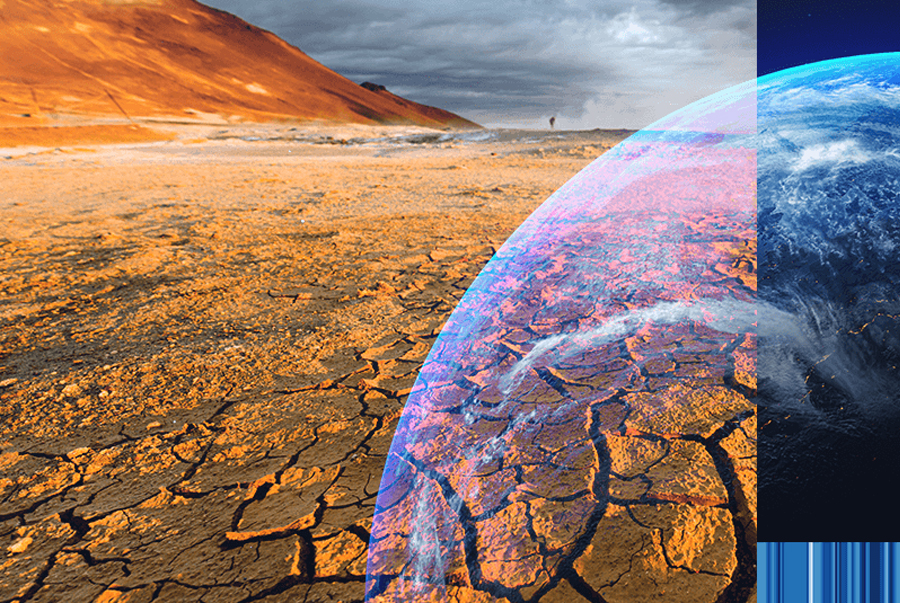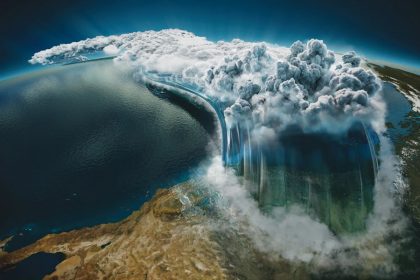Hi readers, has your climate and/or environment changed or not? Hope you would have been trying it hard. Good luck to you.
Experts says that global climate change has typically occurred very slowly, and over thousands or millions of years.
Then why so much hue and cry?
There are many factors that causes climate change: important among them includes changes in the sun, emissions from volcanoes, variations in Earth’s orbit and levels of carbon dioxide (CO2) and other greenhouse gases (GHS) however, as I mentioned in the first blog, two major factors:
Milankovitch cycles and
Atmospheric composition (only? Oh No) are said to be the biggest contributor to the climate change.
So, let’s first talk about the
Milankovitch cycles which refer to changes in the Earth’s movements and corresponding effects on its climate over time ranges from tens of thousands to hundreds of thousands of years. These movements are of three types
- Precession: Axial precession is the trend in the direction of the Earth’s axis of rotation
- Obliquity: Measure the angle of the Earth’s axial tilt with respect to the orbital plane and
- Eccentricity: Measures the departure of the ellipse (a circle that stretched in one direction, to give it the shape of an oval) from circularity

Precession. As earth rotates upon it axis, it vibrates (wobble) slightly due to tidal force which is a combined result of gravity and rotation and arises because of the gravitational influences of sun and moon. The effect of this tidal force is not constant because the nearest side toward the sun is attracted more compared to the opposite side. This difference causes earth to stretch and/or bulge at equator, which in turn affects its rotation. The trend in the direction of this wobble relative to the fixed position of stars is known as axial precession. Greater Earth’s axial tilt indicated more extreme seasons. Larger tilt angle favor period of de glaciation (the melting of glaciers and ice sheets). The cycle of axial precession spans about 25 771.5 years.

Eccentricity is the Earth’s annual movement around sun which is not nearly circular but is slightly elliptical (oblique) due to the pull exerted by two big gaseous planets: the Jupiter and the Saturn. Hence, the eccentricity of the orbit is a measure of how much the shape of Earth’s orbit departs from perfect circle. These variations affect distance between Earth and the Sun. When Earth’s orbit is in its most elliptic shape, there is more distance between the earth and the sun: the highest eccentricity (0.0679) and when the earth orbit is nearly circular, its eccentricity is the lowest (0.000055) which means it is closer to the sun and thus, receive 23% more solar radiation at points closest to the sun compared to the points which are far away from the sun. The major component of these variations occurs with a period of 413000 years. Currently, Earth’s eccentricity is (0.017) near its least elliptic (most circular) and is very slowly decreasing, in a cycle that spans about 100,000 years. This means the earth is slowly getting away from the sun consequently, the amount of radiation it receives from the sun will gradually reduce (will be getting less warm).

Obliquity is the angle of the earth’s axial tilt with respect to the orbital plane which varies between 22.1o and 24.5o over a cycle of about 41,000 years. The tilt last reached its maximum in 8,700 BCE (11-10,000 years ago) and is now in the decreasing phase of its cycle and will reach its minimum around the year 11,800 CE.
It is very important to note that changes in these factors all have effects on climate. If Earth had a greater axial tilt, say 30 degrees instead of about 23.5 degrees, the contrast between seasons in both hemispheres would be greater than they are currently. The higher the angle of the axial tilt, or the higher the obliquity, the more intense the difference between seasons becomes.
So, you got the point dear readers?
Milankovitch cycle’s induced climate change is beyond “mitigation and adaptation” because these changes are the part of our solar system: the movement of which we cannot control.
All the three components of Milankovitch cycles indicated that we are going toward milder (cooler) summer and warmer winter but not “warming” per se. Then, where does it came from?
Climate expert sitting in UN Intergovernmental Penal of Climate Change (IPCC) says that it is solely the result of human activities i.e., industrialization and agriculture: both massively revolves around humans. OK!
Let’s see the contribution of atmospheric composition in climate change
Atmospheric composition
Earth’s atmosphere is composed of about 78 percent nitrogen, 21 percent oxygen, 0.9 percent argon, and 0.1 percent other gases. Trace amounts of carbon dioxide (pl. note the word trace), methane, water vapor, and neon are some of the other gases that make up the remaining 0.1 percent.
The significance of atmospheric composition is the absorption of some sun irradiation and its return to the Earth’s surface so as to increase temperature. This is referred to as the greenhouse effect. When solar radiation from the sun passes through the Earth’s atmosphere in the form of visible light, it heats the Earth, and much of that heat radiates back towards space in the form of thermal energy that is absorbed by the Earth atmosphere.
This trapping of thermal radiation or heat in the Earth’s atmosphere is called the greenhouse effect without which the earth would be too cold to sustain human life. Water vapor in the Earth’s atmosphere is a leading cause of the greenhouse effect. Greenhouse gases (and pollutants e.g., smoke from burning of crop residues, heavy dust particles, saw dust etc., that usually cause smog in big cities in winter) including carbon dioxide and methane, trap additional heat. The more these gases build up in the Earth’s atmosphere, the hotter it gets (Global warming) https://insideclimatenews.org/climate-101/what-is-the-greenhouse-effect/?gclid=CjwKCAjwquWVBhBrEiwAt1KmwgFQuIXxEMBZwdJ8UVxURiKbHoye1MTz3e2QiF_CeOXRDCBls4e97hoCNnIQAvD_BwE
Ocean is also crucial to climate change. It acts as a control knob: absorbing or releasing Co2 and heat in response to changes in the atmosphere. As the atmospheric concentration of Co2 increases, its excess gets dissolved in ocean’s surface water thereby decreasing its pH which currently is around 8.1 (or alkaline). As the ocean continue absorbing Co2, the pH decreases, and the ocean becomes more acidic because Co2 dissolves in water produces a weak carbonic acid thus, lowering the pH. This drop of pH is Ocean acidification which has negative effects for marine lives.
But oceans also resales Co2 in the atmosphere in response of rising temperatures firstly because melting sea ice increases the rate at which ocean’s water mixes, which dig up CO2-rich deep ocean waters. Secondly, when ocean warms up, just like warming up Coke bottle, it drives the gas out.
The oceans also absorb excess heat from Earth’s system which thereby balances the global temperatures. Scientists believes that ocean absorbs more than 90 percent of the excess heat, attributed to the greenhouse gas emissions. Land areas and the atmosphere absorb some sunlight whereas oceans absorbed most of sun’s radiation (energy) especially in the tropical waters around the equator where the ocean acts as a massive heat-retaining solar panel. Oceans however, releases enormous amount of heat with little change in temperature.
Changes in atmosphere composition over the past several decades primarily reflect changes in human activities such as burning fossil fuels, releasing chemicals into the atmosphere, reducing the amount of forest cover, and the rapid expansion of farming and industries, all releases CO2 into the atmosphere and changing the balance of the climate system. Temperature, rainfall, and humidity, which affects the economic importance, geographical distribution, and management of diseases effecting crop production also changes atmospheric composition.
Today’s atmosphere contains more greenhouse gas molecules thereby increasing more infrared energy emitted by the surface that ends up absorbing by and warming of atmosphere which in turn radiate back its extra energy to the earth’s surface, which again raises its temperature, and the cycle goes on.
The major gases in the Earth’s atmosphere are very similar in mass, which means large convection currents can develop which can carry energy from the surface into the upper atmosphere thus, creating the prevailing winds and jet streams that circulate the atmosphere. As the earth’s atmosphere heats up, it collects, retains, and drops more water, changing weather patterns and making wet areas wetter and dry areas drier. Higher temperatures worsen and increase the frequency of many types of disasters, including storms, floods, heat waves, and droughts.
The question is that what triggers climate change impacts more? a changing climate or changing non-climatic factors? Don’t you think dear readers, that it is not only the climate that is changing but the system that is exposed to this climate is also changing? The climate change is being discussed vigorously but what about non-climate factors such as land use, demographic, and socio-economic factors including poverty and hunger and communicable diseases? Don’t you think that these factors are equally or even more responsible for climate change?
Wang Yi: the state councilor and Foreign Minister of China says,
“Climate change is a global consensus. We need to respond to this challenge with concerted global efforts according to the principles of common but DIFFERENTIATED RESPONSIBILOTIES”
That’s all for now dear readers. I will see you next week with what these greenhouse gases are? How they have been and are being inducing global warming? What the IPCC says? and have been saying about it: all for your understanding, so that you can made the right decisions for you and your surroundings. Take care bye





